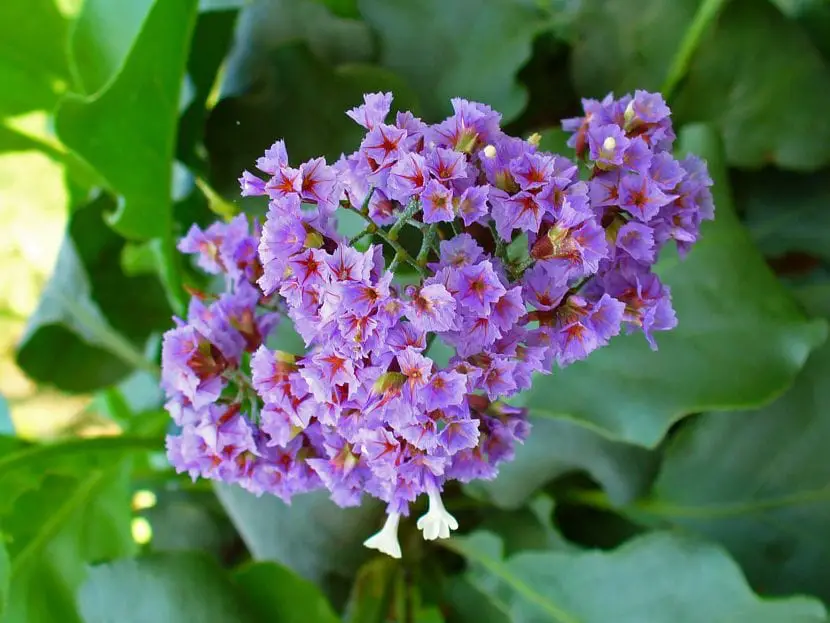
L. arborescens
If you have been looking for resistant plants that also produce very decorative flowers for a long time without success, you can stop looking. There are some, belonging to the genus limoniumwhich produce inflorescences made up of a large number of small lilac, blue or white flowers that are very, very beautiful.
But they are not only very decorative but also they withstand the sea floor and high temperatures wellso if you live near the beach, surely with these plants you will not have any problems.
Limonium characteristics

L. low
Our protagonist is the botanical genus composed of more than 120 species of perennial herbs distributed in Europe, Asia, Africa, Australia and North America, such as Limonium sinuatum, Lemon vulgare o Malachite lemon which are the best known and easiest to find in nurseries. They are mainly concentrated in the Canary Islands, where there are more than a hundred different ones. Known as statice or statice, they grow near the coasts and in the marshesuntil reaching a height of between 10cm to 2m.
The leaves are simple, 1 to 30cm long by 0,5-10cm wide. The flowers are small, 4 to 10mm long, and are grouped in corymb-shaped inflorescences or in a branching panicle. Once they are pollinated, the fruit begins to mature, which is a small capsule that contains a single seed.
How are they cared for?

L. sinuatum
Are you liking this plant? If so, here is your care guide so you can enjoy it from day one:
Location
The Limonium It has to be in an area where it is in direct sunlightideally throughout the day. This way it will be able to grow and develop without problems, producing beautiful flowers every year.
Soil or substrate
It grows in all types of soils and substratesbut it is very important that you have very good sewer system as it is sensitive to root rot due to excess water. In the event that in your garden there is a soil that has difficulty absorbing the precious liquid, you can make a hole large enough for a block (of the squares) to fit, introduce it inside and fill it with universal growing substrate mixed with perlite in equal parts.
Irrigation
During the summer it has to be frequent2 or 3 times a week. The rest of the year it will be watered less, every 4 or 5 days. If you have a plate underneath, remove the excess water ten minutes after watering.
Subscriber

L. pectinatum
During the warm months, and especially during the flowering season, it is highly recommended that you fertilize it with a liquid fertilizerSuch as guano or, from time to time, the extract of seaweed. The latter should not be abused, as it is very alkaline and could cause problems for the plant. Therefore, the indications specified on the packaging must always be followed.
Pests
- Red spider: it feeds on the cells of the leaves, in which spots of a very light white color will appear. It is eliminated with acaricides.
- Aphids: They usually perch on flower buds, which serve as food, but you can find them on green leaves and tender stems. You can remove them with neem oil.
- Trips: you will find them on the underside of the leaves, where they will leave white spots (their feces). To eliminate them, you can use the natural insecticide pyrethrin, or opt for other synthetics whose active ingredient is formethanate or malathion.
Diseases
- Botrytis: produces rot in all parts of the plant. Treatment is with fungicide.
- Virus: cause mosaics on the leaves and stunted growth. Unfortunately, there is no treatment.
Multiplication
The seeds of these wonderful plants have to be sown in autumn or late winter, when the temperature ranges between 18 and 20 degrees Celsius. For it, you have to follow this simple step by step:
- The first thing to do is fill the seedbed with a mixture of peat with clean river sand in equal parts.
- Afterwards, the seeds are placed on the surface of the substrate, leaving a distance of 2-3cm between them, and they are treated with a spray fungicide to prevent the proliferation of fungi.
- They are then covered with a thin layer of substrate, just enough so that the wind cannot blow them away.
- Then, they should be taken to an outdoor area, very bright.
- Finally, the container that you are using as a seedbed is inserted into a tray and watered by directing the water to said tray.
The first seeds will germinate in a maximum period of 14 days.
Rusticity
Limonium resists cold, but not frost. If the temperature drops below 0ºC you will need protection. But not everything is bad: you can take advantage of the winter months to decorate the interior of your home . Put it in a very bright room, and it is sure to make it to spring safely.

L. perezii
What did you think of Limonium?

One thought on “Limonium, a plant to give color to your garden”